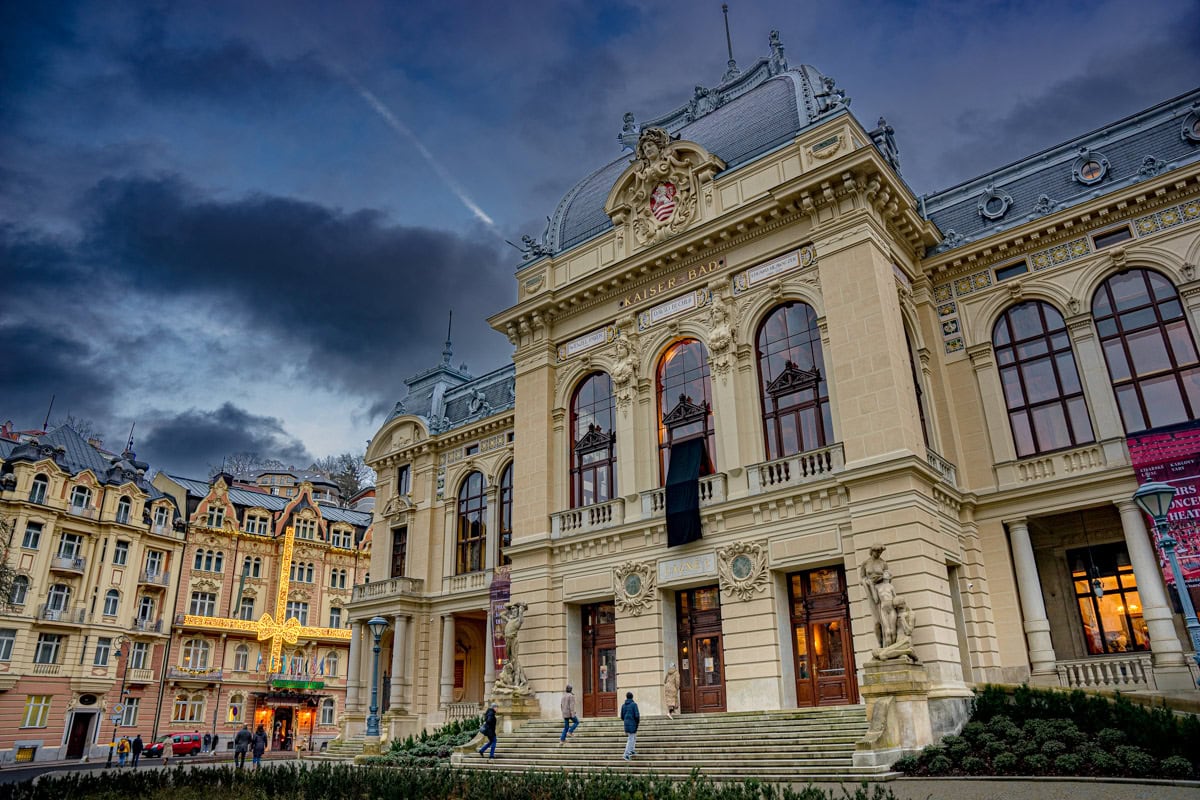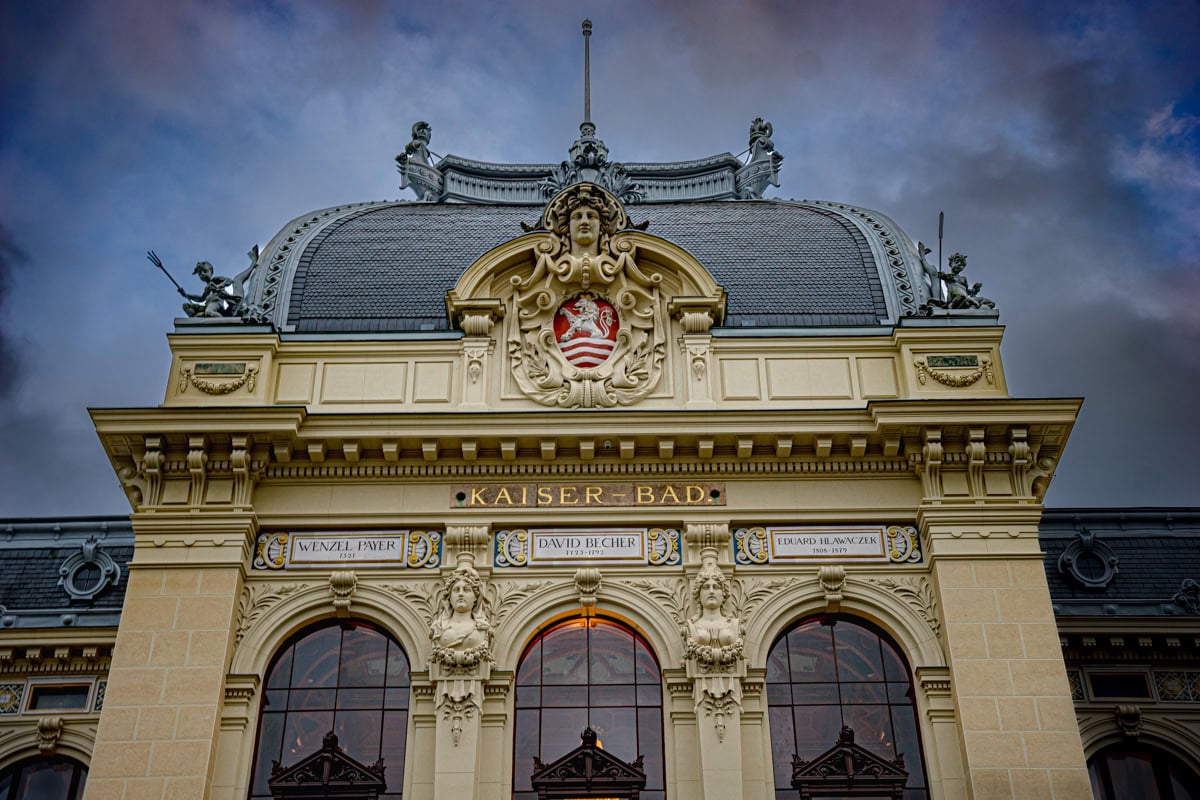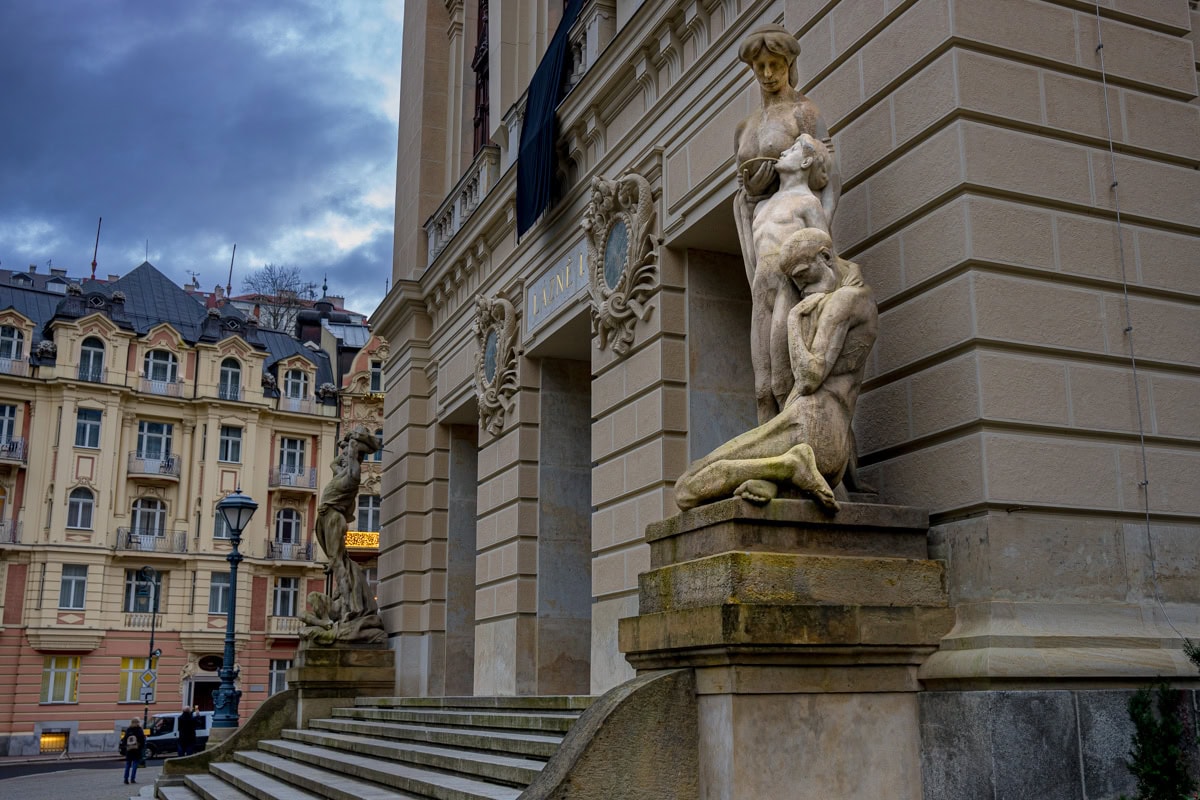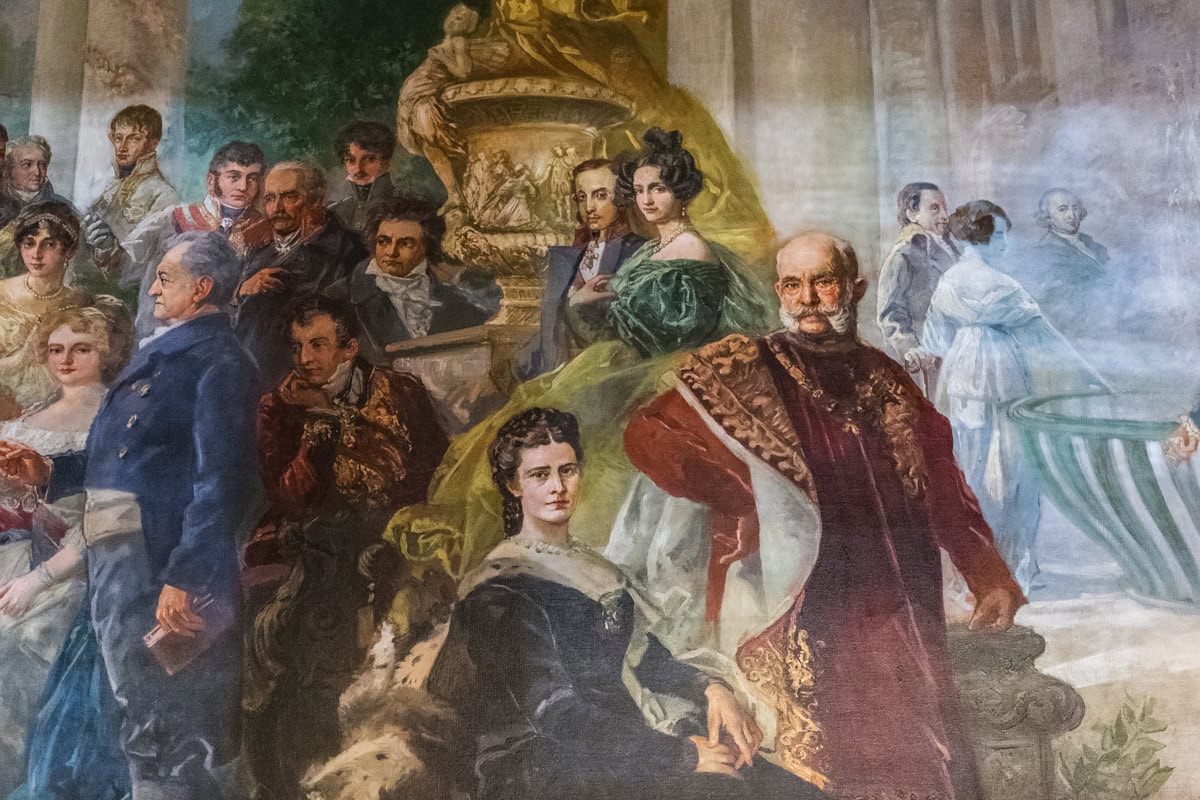Kaiserbad, or the Imperial Spa, is a National Heritage Site in Karlovy Vary (formerly Karlsbad). We went on a guided tour of the Imperial Spa during our visit, and now we’ll give you the tour. Visiting Kaiserbad transports you back to the city’s heyday when anyone who was anyone flocked to the spas of Karlsbad.
The Imperial Spa is unique in many ways and personifies the golden age of the city spas. The building’s ornateness and rich artistic decoration demonstrate the importance and wealth of Karlovy Vary at the turn of the 19th and 20th centuries.
Architecture, history or James Bond fanatics will want to put Kaiserbad on their Karlovy Vary itinerary.


Please note: This post may contain affiliate links. This means I may earn a commission if you make a purchase by clicking a link (at no extra cost to you).
Brief History of Kaiserbad in Karlsbad

The Kaiserbad, designed by the noted Viennese architects Ferdinand Fellner and Herman Helmer, was built between 1893 and 1895 in Karlsbad and officially opened on May 5, 1895.
Renowned for its advanced *balneological facilities, the spa was considered the most sophisticated within the Austro-Hungarian Empire, merging artisanal craftsmanship with cutting-edge 19th-century technology.
* balneological = the science of the therapeutic use of baths
At the time, the Imperial Spa boasted modern amenities unprecedented for its era. For instance, while most wealthy households shared communal toilets, the spa featured private flush toilets in every bathroom and public area, reflecting the opulence and forward-thinking design of the building. Its structural use of reinforced concrete was cleverly masked by a façade reminiscent of monumental French baroque châteaux or opera houses.

The interior decor and equipment were tailored to meet the high expectations of Karlovy Vary’s elite visitors, typical of the late 19th century when European spas were at their zenith. These spas were essential to the lifestyle of the aristocracy and upper classes, offering treatments for various health issues amid unparalleled luxury that far surpassed the living standards of most Europeans at the time.
Originally named the Imperial Spa, it was renamed Spa I in 1918 and functioned as a spa into the 1980s. It later hosted a casino in its Zander Hall until the entire facility was closed in 1994. The building deteriorated until it was handed over to the Karlovy Vary Region in 2008. Since then, restoration efforts have been underway, and it has been designated a National Cultural Monument, preserving its historical and cultural significance.
Women’s Lounge

The Imperial Spa building was initially segregated into sections for men and women.
On our guided tour, we first visited the Ladies’ Lounge, a space designed for women to relax following their spa treatments. Adjacent to this was the waiting room, where guests would stay until their baths or procedures were ready.
The spa’s ground and first floors are elaborately decorated with paintings. In the waiting room, we see one of its prized artworks—a painting by the esteemed Karlovy Vary artist Wilhelm Schneider. This is one of two paintings he crafted for the spa.


These paintings essentially serve as monumental guest books, featuring portraits of over a hundred notable figures who visited Karlovy Vary up to 1914, when the paintings were completed.
Our guide pointed out noteworthy individuals, including the Austrian general Albrecht of Wallenstein, Russian Tsar Peter the Great, and Anne of Denmark, Electress of Saxony, depicted holding a glass of Aquavit—the forerunner to the now-famous Becherovka. You can spot Empress Maria Theresa with her son Joseph II on the painting’s far right.
Men’s Lounge

Like the Ladies’ Lounge, the Men’s Lounge provided a retreat for gentlemen to unwind post-treatment.
Adorning the walls of this space is another striking visual guestbook by Wilhelm Schneider, portraying prominent figures of the 19th century. Among them are renowned composers like Beethoven, Brahms, and Wagner, literary giants such as Goethe and Schiller, and political figures like chancellors Metternich and Bismarck.

At the centre of this painting are Emperor Francis Joseph I and his wife, Elizabeth, known as Sisi. It was after Emperor Francis Joseph that the spa got its name Kaiserbad – Imperial Spa.
These depictions offer a fascinating glimpse into the illustrious clientele that frequented this historic establishment, enriching our understanding of its cultural and historical significance.
Staircase Hall


The staircase hall of Kaiserbad feels more like we’re in a grand castle or an opera house than a spa. Like elsewhere, it is a lavish affair with marble and gold trimmings galore.
The staircase features two stunning wall paintings by Prague artist Alexander Jakesch. These paintings depict the sleeping water nymph Egeria and Charles IV’s discovery of the Karlovy Vary springs. They are not just beautiful artworks but also significant representations of the spa’s history and legends.

The water nymph symbolizes the power of the Karlovy Vary springs, while the painting of Charles IV tells the story of the origins of Karlsbad as a spa town.
Legend has it that during his stay at nearby Loket Castle, Charles IV often went on hunting trips in the surrounding forests. On one such hunt, his dog chased a deer and accidentally fell into a pool of scalding hot water. Following this event, the emperor went to the forest spring with his entourage and doctors. Charles IV had experienced similar warm springs during his travels, and when he bathed in the warm water, he miraculously found relief from the pain in his legs. So, he decided to build a small town around these springs.


Back in the day, busts of Emperor Franz Josef and his wife Elizabeth welcomed guests, but when Czechoslovakia was created, all reference to the Habsburg monarchs was forbidden by law, so they were removed.
Today, the bust of the famous Karlovy Vary doctor Jean de Carro is the one to welcome visitors heading upstairs
Women’s Changing Room

In Zander’s Hall, recognized as the first modern gymnasium of the empire, exercise times for men and women alternated regularly. This led to separate changing rooms on either side of the hall.
While the men’s changing room is quite simple in decoration, the women’s changing room is one of the building’s most exquisite spaces, with faux wooden columns featuring intricate decorations. This room provides access to Zander’s Hall and connects to a neighbouring corner room where massages were administered.
Snakes serve as a recurring decorative motif throughout the building—a nod to the ancient symbol of Asclepius and medicine. These serpentine motifs can be found on various decorative elements, including the wooden columns in Zander’s Hall, the main staircase, and even the exterior façade.
Zander’s Hall

Zander’s Hall stands out as the highlight of the Imperial Spa, resembling a regal residence, ballroom, or opulent casino. However, its true purpose was revolutionary for its time—it served as the first fitness studio in the Czech Republic.
Constructed in 1895, the hall spans an impressive 300 square meters and is named after Swedish doctor Gustav Zander. In the late 19th century, Zander pioneered a novel approach to exercise using specialized mechanical machines. Zander believed that systematic training on such machines offered multifaceted health benefits.
In an era where sedentary lifestyles were increasingly common, Zander advocated for regular physical activity as essential for restoring or maintaining health. His innovative fitness concept gained popularity rapidly, with Zander opening institutes in Stockholm, London, and New York. By the early 20th century, there were 80 Zander fitness studios in Germany alone.


Despite its luxurious appearance, much of the hall’s decorations were crafted to mimic more expensive materials. For instance, the wooden ceilings and wall panelling are made of concrete and plaster, cleverly grained to resemble wood. Similarly, the walls feature painted imitations of costly silk wallpapers.
What is original are the striking canvases on the walls, created by artist Eduard Lebiedzki just four years after the spa’s opening. Among them, two larger paintings depict scenes from the ancient Olympic Games—a fitting tribute to the hall’s function as a space dedicated to physical wellness and exercise. On one side, the games themselves unfold, traditionally exclusive to men, while on the opposite side, women are portrayed welcoming the victorious athletes
James Bond & the Karlsbad Kaiserbad

The Kaiserbad Spa in Karlovy Vary famously served as a filming location for the 2006 James Bond film Casino Royale.
In the movie, the Imperial Spa masqueraded as the extravagant Casino Royale in Montenegro, where Daniel Craig’s 007 played in a high-stakes poker game. The splendid architecture and lavish interiors were ideal for setting the scene of the film’s intense and glamorous sequences.
This role in a major blockbuster not only showcased the spa’s grandeur but also linked it to the thrilling world of espionage and high stakes depicted in the James Bond series. Fans of the franchise often visit the spa to immerse themselves in its historical and architectural beauty and to relive a piece of cinematic history where the iconic spy once roamed.
The film’s popularity is also believed to have sparked renewed interest in the spa, contributing to its renovation efforts that began in 2008.
